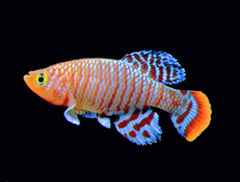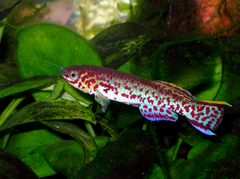
The mummichog is a small killifish found along the Atlantic coast of the United States and Canada. Also known as Atlantic killifish, mummies, gudgeons, and mud minnows, these fish inhabit brackish and coastal waters including estuaries and salt marshes. The species is noted for its hardiness and ability to tolerate highly variable salinity, temperature fluctuations from 6 to 35 °C, very low oxygen levels, and heavily polluted ecosystems. As a result, the mummichog is a popular research subject in embryological, physiological, and toxicological studies. It is also the first fish ever sent to space, aboard Skylab in 1973.

Nothobranchius is a genus of small, freshwater killifish, classified in the family Nothobranchiidae in the order Cyprinodontiformes. There are about a hundred species in the genus, many with very small distributions. They are primarily native to East Africa from Sudan to northern South Africa, whereas a dozen species are found in the upper Congo River Basin; the greatest species richness is in Tanzania.

Fundulus is a genus of ray-finned fishes in the superfamily Funduloidea, family Fundulidae. It belongs to the order of toothcarps (Cyprinodontiformes), and therein the large suborder Cyprinodontoidei. Most of its closest living relatives are egg-laying, with the notable exception of the splitfin livebearers (Goodeidae).
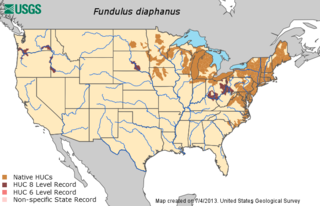
The banded killifish is a North American species of temperate freshwater killifish belonging to the genus Fundulus of the family Fundulidae. Its natural geographic range extends from Newfoundland to South Carolina, and west to Minnesota, including the Great Lakes drainages. This species is the only freshwater killifish found in the northeastern United States. While it is primarily a freshwater species, it can occasionally be found in brackish water.
Nothobranchius neumanni is a species of killifish in the family Nothobranchiidae. It is endemic to Tanzania. It occurs in both perennial and seasonal wetlands including rivers, lakes and ponds where it most likely feeds on planktonic crustaceans. This species was described as Fundulus neumanni by Franz Hilgendorf in 1905. The specific name honours Hilgendorf's companion on some of his expeditions to Africa, the German ornithologist Oscar Neumann (1867-1946).
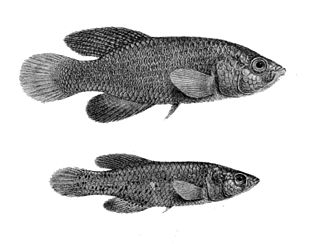
The spotted killifish is a small, short lived species of fish, an African rivuline from the family Nothobranchiidae. These fish are native to many isolated freshwater pools located in the savannah depressions of east Africa, specifically Malawi, Mozambique, Zimbabwe, and South Africa. This species of fish occurs in ephemeral waters and killifish eggs can survive long periods of dehydration. The word killifish likely comes from the Dutch kil for kill.

Nothobranchius palmqvisti is a species of killifish in the family Nothobranchiidae. It is found in Kenya and Tanzania. Its natural habitats are swamps and intermittent freshwater marshes. This species was described as Fundulus palmqvisti by Einar Lönnberg in 1907 with the type locality being Tanga in the Usambara Mountains of north eastern Tanzania, the type being collected on the 1905-06 Sjöstedts Kilimandjaro-Meru Expedition. The specific name honours the patron of that expedition, Gustaf Palmqvist.
The blue notho, or Patrizi's notho is a species of killifish in the family Nothobranchiidae. It is found in Kenya and Somalia. Its natural habitat is running water. The males are usually around 5.0 centimetres (2.0 in). In the aquarium the females lay their eggs on bottom peat. This species was described as Fundulus patrizii by Decio Vinciguerra in 1927 with a type locality of the Harenaga swamps, near mouth of the Juba River in southern Somalia. Vinciguerra gave this fish the specific name of patrizii in honour of the collector of the type Saverio Patrizi Naro Montoro (1902-1957), an Italian explorer, zoologist and speleologist.

Rivulus is a genus of small freshwater fish in the Cyprinodontiformes family Rivulidae. It was traditionally considered to be the largest genus in its family; however, the genus's size is currently in dispute. Wilson J. E. Costa split this genus into several new genera in 2004 and 2011, leaving only a few Greater Antillean species in Rivulus itself. Despite being moved to other genera, some of the species retain the common name "rivulus", like the well-known mangrove rivulus. Shortly after the review by Costa, another review authored by J.H. Huber refuted the split, moving the proposed genera back in Rivulus and again making the genus the largest in the family Aplocheilidae.
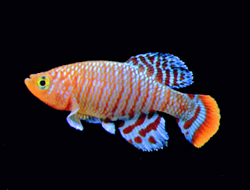
Nothobranchiidae are a family of bony fishes containing roughly 300 species, also known as African rivulines. They are small killifish, usually measuring about 5 centimetres (2.0 in). They are limited to Africa, living in fresh water but being also somewhat salt-tolerant. They are also found in muddy or brackish water. Some species are kept as aquarium pets. They have frilly fins and many are brightly colored. They were formerly included in the family Aplocheilidae ; a return to that broader family has recently been suggested.
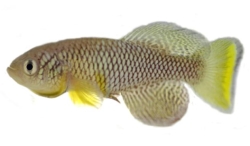
Nothobranchius furzeri, the turquoise killifish, is a species of killifish from the family Nothobranchiidae native to Africa where it is only known from Zimbabwe and Mozambique. This annual killifish inhabits ephemeral pools in semi-arid areas with scarce and erratic precipitations and have adapted to the routine drying of their environment by evolving desiccation-resistant eggs that can remain dormant in the dry mud for one and maybe more years by entering into diapause.
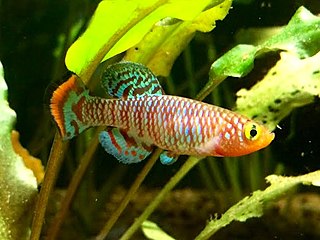
Nothobranchius rachovii, the bluefin notho, is a species of freshwater annual killifish from Mozambique. It can grow up to 6 cm (2.4"). It is popular among killifish enthusiasts, who raise them from eggs in aquaria.
Austrofundulus is a genus of killifish in the family Rivulidae native to northern Colombia, northern Venezuela and southwestern Guyana. They are annual killifish where adults generally have a short life in temporary ponds or swamps and the eggs experience a period of drought, only hatching when again covered by water.

Austrolebias is a genus of killifish in the family Rivulidae. These annual killifish live in temporary pools, swamps and streams in the Río de la Plata, Patos–Mirim and Mamoré basins in South America.

Melanorivulus is a genus of South American freshwater fish in the family Rivulidae. Most species are endemic to the Río de la Plata, eastern Amazon, Tocantins–Araguaia and São Francisco basins in Brazil, but a few members of this genus range west into Bolivia, south into Paraguay and Argentina, and east to Parnaíba and Sergipe in northeastern Brazil. Only M. schuncki occurs north of the Amazon River. They inhabit shallow waters, generally 5–30 cm (2–12 in) deep, at the margins of streams in open or fairly open habitats like the Cerrado or Cerrado–Amazon transition. Many have tiny ranges and are seriously threatened.
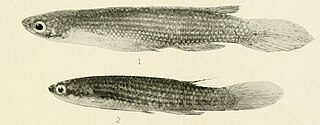
Anablepsoides is a genus of killifish in the family Rivulidae native to tropical South America and the Lesser Antilles. The majority are from the Amazon and Orinoco basins, as well as freshwater systems in the Guiana Shield, but a few species are from northern Venezuela, northeastern Brazil and the Lesser Antilles. Although largely restricted to lowlands, a few species occur in the lower East Andean foothills. They are mostly found in shallow fresh water swamps, streams, edges of rivers, ponds and pools, but a few may occur in brackish estuaries. They are able to jump over land and breathe air for short periods, allowing them to access isolated waters inhabited by few or no other fish. Several Anablepsoides species have small distributions and some are seriously threatened by habitat loss; the entire known range of A. xinguensis is in the area flooded by the Belo Monte Dam.

The bayou killifish or bayou topminnow is a topminnow-like fish that thrives primarily in the shallow waters off the shores of the Americas, as well as fresh and brackish waters. Feeding off of small vertebrates and invertebrates, this fish displays reproduction techniques unique to its species.
Anne Brunet is the Michele and Timothy Barakett Endowed Professor and the co-director of the Paul F. Glenn Laboratories for the Biology of Aging at Stanford University School of Medicine. Her lab studies mechanisms of aging and longevity.

The mitochondrial theory of ageing has two varieties: free radical and non-free radical. The first is one of the variants of the free radical theory of ageing. It was formulated by J. Miquel and colleagues in 1980 and was developed in the works of Linnane and coworkers (1989). The second was proposed by A. N. Lobachev in 1978.
Nothobranchius lucius is a species of killifish, an African rivuline which is placed in the family Nothobranchiidae. It is endemic to Tanzania.
